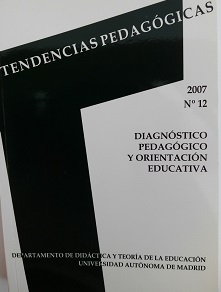Teacher's assessment of English in Early Childhood Education and First Cycle of Primary Education on the Use of ICT in the Teaching-Learning of this Language
Keywords:
Results, research, ICT, questionnaires.Abstract
This article intends to offer the results of a research devoted to analyse the use of ICT to teach English in Kindergarten and Primary Education in schools of the Autonomous Region of Madrid. For that purpose, we wrote two questionnaires: one for the school management team and the other for the English teachers at those levels. In such a questionnaires, there are data related to computer resources used, suitability to the pupils’ needs, etc. The questionnaires were written with a format mixing questions containing alternatives of closed answer with open questions.Downloads
References
Alick, D. (1999). “Integrating Multimedia and Multiple Intelligences to Ensure Quality Learning in a High School Biology Classrooom”. EDUC 685- Multimedia Literacy, Diciembre 7, Bautista, A. y Jiménez Benedit, M.S. (1991). “Uso, Selección de Medios y Conocimiento Práctico del Profesor”. Revista de Educación (296), 299-326.
Coleman, G. (1996). “Integrating CALL into the Language Syllabus”. On-Call Journal, 10 (1), 21-28.
Cooper, B.& Brna, P. (2002). “Supporting High Quality Interaction and Motivation in the Classroom Using ICT: the social and emotional learning and engagement in
the NIMIS project”, en Education, Comunication & Information, 2, 2/3: 113-138.
Chapelle, C. A. (2001). Computer applications in second language acquisition: Foundations for teaching, testing, and research. Cambridge: Cambridge University Press.
García Martín, P.J. (2000). “Nuevas tecnologías aplicadas a la didáctica de segundas lenguas (inglés)”. En M. Cebrián y J. M. Ríos (eds.), Nuevas tecnologías aplicadas
a las didácticas especiales. Madrid: Pirámide, 51-63.
Garrett, N.(1988). “Computers in foreign language education: Teaching, learning, and language-acquisition research”. ADFL Bulletin 19 (3), 6-12.
Gómez, M. y López, D. (2001). “Actividades didácticas con el ordenador para la enseñanza del inglés”, en M. Cebrián (ed.), Actividades con el ordenador en el aula,
-77. Málaga: Apple/Grupo Investigación (Humo 369) Universidad de Málaga, 75-77.
Grané, M. (2000). “Grimm, ideas para moverse”. En M. Cebrián (ed.), Internet en el Aula, proyectando el futuro. Málaga: Apple/Grupo Investigación (Humo 369).
Universidad de Málaga, 123-164.
Gutiérrez, A. y Gómez, M. (2004). “ADIM: El aula digital interactiva multiplataforma”. Ponencia en el Seminario Profesional “La Revolución de la tecnología Inalámbrica en Educación”, organizado por el Centro Superior de Estudios Universitarios La Salle, celebrado en Madrid en Mayo de 2004.
Hearn, I. y Garcés, A. (2003). Didáctica del inglés, Madrid: Pearson Prentice Hall.
Jonassen, D. H., Mayes, T. y Mcaleese, R. (1993). “A manifesto for a constructivist approach to use of technology in higher education”. En T.M. Duffy, J. Lowyck,
D.H (Eds.), Designing constructivist learning environments. Heidelberg, FRG: Springer-Verlag, 87-108.
Marsh, D. (2002). CLIL/EMILE, The European Dimension: Actions, Trends and Foresight Potential. DG Education and Culture, European Comisión.
Sánchez, M.P; García, M.C; Guerra, T. (2003). Las Nuevas Tecnologías son Políglotas. Comunidad Escolar (714), 14-16.
Serna, M.P. (2001). “Mis primeros pasos con el ordenador en la clase de inglés”, en M. Cebrián (ed.), Actividades con el ordenador en el aula. Málaga:
Apple/Grupo Investigación (Humo 369) Universidad de Málaga, 87-90.
Sprenger, R. (2002). Internet et les classes de langue. Paris: Ophrys.
Torres, D.; Pérez, I.; Hearn, I. (2003). “Recursos”, en I. Hearn y A.Garcés (eds.), Didáctica del Inglés. Madrid: Pearson Prentice Hall, 222-263.
Warschauer, M. y Meskill, C. (2000). “Technology and second language learning”, en J. Rosenthal (ed), Handbook of undergraduate second language education. Mahwah, New Jersey: Lawrence Erlbaum, 303-318.
